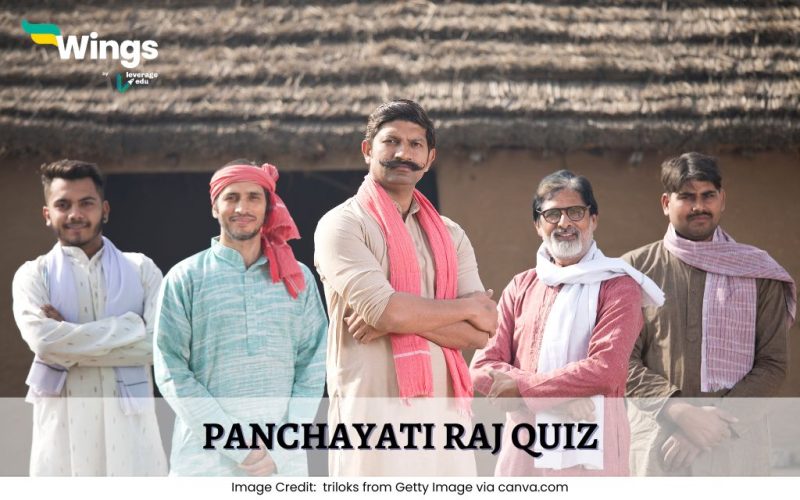Test your knowledge of India’s grassroots democracy with this engaging Panchayati Raj Quiz! From Gram Panchayats to Zila Parishads, this quiz covers key aspects of rural local governance, constitutional amendments, and decentralized administration. Whether you’re a student, competitive exam aspirant, or just curious about village self-governance, these questions will help you understand the three-tier Panchayati Raj system, the 73rd Amendment Act, and the roles of Gram Sabha, Sarpanch, and Panchayat Samiti. Let’s get started and see how well you know India’s decentralized power structure and its impact on rural development!
This Blog Includes:
- Panchayati Raj Quiz with answers
- Q1. What’s the main local government in a village called?
- Q2. Which big rule in India’s law talks about setting up Village Panchayats?
- Q3. When do we celebrate National Panchayat Day every year?
- Q4. Which group first said that India should have a three-level Panchayat system?
- Q5. How many years do Panchayat members serve after being elected?
- Q6. What important part was added to India’s laws to make Panchayats official?
- Q7. What is the most important task of the Gram Sabha (the big meeting of all adults in a village)?
- Q8. What made it a rule to save some seats for women in Panchayats?
- Q9. What’s a common task for Panchayats?
- Q10. Who is usually the main leader of the Gram Panchayat?
- Q11. What’s the name for all the adults who live in one village, when they’re all together?
- Q12. Which of these is NOT usually a job of the Gram Panchayat?
- Q13. What is the top level of the Panchayat system in a district called?
- Q14. Which of these is a job of the Zila Parishad?
- Q15. Who conducts the elections for the Panchayats?
- Q16. What is the main idea behind Panchayati Raj?
- Q17. How many subjects are listed in the Eleventh Schedule of the Constitution for Panchayats to handle?
- Q18. What is another common term for the head of the Gram Panchayat?
- Q19. Which administrative level does the Panchayat Samiti usually work at?
- Q20. Which of these is a key goal of the Panchayati Raj system?
- Q21. How are the members of the Gram Panchayat usually chosen?
- Q22. What kind of body is the Gram Sabha?
- Q23. What is a key feature that the 73rd Amendment Act brought to Panchayati Raj?
- Q24. What is the role of the Panchayat Samiti in relation to the Gram Panchayats?
- Q25. Which of these is a step towards making Panchayats stronger and more independent?
- Answer Key
- FAQs
Panchayati Raj Quiz with answers
Read each question carefully and take your time to understand what each question is asking before selecting or providing your answer.
Q1. What’s the main local government in a village called?
(A) City Council
(B) Panchayat Samiti
(C) Gram Panchayat
(D) State Assembly
Q2. Which big rule in India’s law talks about setting up Village Panchayats?
(A) Rule 243
(B) Rule 40
(C) Rule 73
(D) Rule 14
Q3. When do we celebrate National Panchayat Day every year?
(A) January 26th
(B) August 15th
(C) April 24th
(D) October 2nd
Q4. Which group first said that India should have a three-level Panchayat system?
(A) Ashok Mehta Committee
(B) L.M. Singhvi Committee
(C) G.V.K. Rao Committee
(D) Balwant Rai Mehta Committee
Q5. How many years do Panchayat members serve after being elected?
(A) 3 years
(B) 4 years
(C) 5 years
(D) 6 years
Q6. What important part was added to India’s laws to make Panchayats official?
(A) Part IV A
(B) Part IX A
(C) Part IX
(D) Part XIV
Q7. What is the most important task of the Gram Sabha (the big meeting of all adults in a village)?
(A) To pick who goes to the block council
(B) To watch over the Gram Panchayat and say yes to its plans and money
(C) To start big projects in the block
(D) To collect taxes from the land
Q8. What made it a rule to save some seats for women in Panchayats?
(A) The 74th Amendment
(B) The 42nd Amendment
(C) The 61st Amendment
(D) The 73rd Amendment
Q9. What’s a common task for Panchayats?
(A) Protecting the country’s borders
(B) Running the train system
(C) Helping farmers with their crops
(D) Managing big banks
Q10. Who is usually the main leader of the Gram Panchayat?
(A) The Block Development Officer (BDO)
(B) The District Collector
(C) The Sarpanch or Pradhan
(D) The Village Secretary
Q11. What’s the name for all the adults who live in one village, when they’re all together?
(A) Gram Panchayat
(B) Panchayat Samiti
(C) Zila Parishad
(D) Gram Sabha
Q12. Which of these is NOT usually a job of the Gram Panchayat?
(A) Looking after local roads
(B) Providing clean water
(C) Deciding national laws
(D) Managing primary schools
Q13. What is the top level of the Panchayat system in a district called?
(A) Gram Panchayat
(B) Panchayat Samiti
(C) Zila Parishad
(D) Block Committee
Q14. Which of these is a job of the Zila Parishad?
(A) Running a single village school
(B) Planning development for the whole district
(C) Managing law and order in a village
(D) Collecting taxes directly from villagers
Q15. Who conducts the elections for the Panchayats?
(A) The Central Election Commission
(B) The State Election Commission
(C) The District Collector
(D) The Village Headman
Q16. What is the main idea behind Panchayati Raj?
(A) To have more government officials in villages
(B) To give power to the people at the local level
(C) To collect more taxes from rural areas
(D) To make all villages the same
Q17. How many subjects are listed in the Eleventh Schedule of the Constitution for Panchayats to handle?
(A) 15
(B) 21
(C) 29
(D) 35
Q18. What is another common term for the head of the Gram Panchayat?
(A) Mayor
(B) Governor
(C) Sarpanch
(D) Chief Minister
Q19. Which administrative level does the Panchayat Samiti usually work at?
(A) Village
(B) Block
(C) District
(D) State
Q20. Which of these is a key goal of the Panchayati Raj system?
(A) To centralize all government power
(B) To promote development at the local level
(C) To weaken the authority of the state governments
(D) To only focus on urban areas
Q21. How are the members of the Gram Panchayat usually chosen?
(A) Appointed by the government
(B) Nominated by village elders
(C) Directly elected by the villagers
(D) Selected by the Zila Parishad
Q22. What kind of body is the Gram Sabha?
(A) An elected council
(B) A meeting of all adult residents of the village
(C) A committee of government officials
(D) A group of village leaders appointed by the state
Q23. What is a key feature that the 73rd Amendment Act brought to Panchayati Raj?
(A) It made it optional for states to have Panchayats
(B) It gave Panchayats official recognition in the Constitution
(C) It removed all powers from the state governments over villages
(D) It only applied to a few select states
Q24. What is the role of the Panchayat Samiti in relation to the Gram Panchayats?
(A) To directly control all their finances
(B) To coordinate their activities and provide support
(C) To abolish them if they don’t perform well
(D) To take over their development projects entirely
Q25. Which of these is a step towards making Panchayats stronger and more independent?
(A) Reducing the number of elected members
(B) Giving them more power to collect their own taxes
(C) Making them entirely dependent on state funding
(D) Preventing women from holding leadership positions
Answer Key
| S.No. | Answer | Reason |
| 1. | (C) Gram Panchayat | The Gram Panchayat is the basic, village-level team that makes decisions for the local area. |
| 2. | (B) Rule 40 | Rule 40 in the Indian Constitution says the government should help villages create their own Panchayats. |
| 3. | (C) April 24th | April 24th is the day we remember when Panchayati Raj became a strong part of India’s laws in 1993. |
| 4. | (D) Balwant Rai Mehta Committee | In 1957, the Balwant Rai Mehta Committee recommended establishing Panchayats at three distinct levels: the village, the block, and the district. |
| 5. | (C) 5 years | Five years is the usual term of service for elected Panchayat members at every level. |
| 6. | (C) Part IX | The Constitution’s Part IX was intentionally designed to handle issues concerning Panchayats. |
| 7. | (B) To watch over the Gram Panchayat and say yes to its plans and money | Their main task is to keep an eye on the Gram Panchayat’s work and provide the necessary approval for its plans and financial matters. |
| 8. | (D) The 73rd Amendment | The 73rd Amendment required that women hold at least one-third of all seats in Panchayats. |
| 9. | (C) Helping farmers with their crops | One of the typical responsibilities of Panchayats is to provide support for farming and local agricultural activities. |
| 10. | (C) The Sarpanch or Pradhan | The elected boss of the village’s Gram Panchayat is the Sarpanch, also known as the Pradhan. |
| 11. | (D) Gram Sabha | Think of the Gram Sabha as a meeting where all the adult villagers come together. |
| 12. | (C) Deciding national laws | National laws are made by the central government, not the Gram Panchayat. |
| 13. | (C) Zila Parishad | The Zila Parishad is the highest level of the Panchayati Raj system at the district level. |
| 14. | (B) Planning development for the whole district | The Zila Parishad’s main role is to plan and coordinate development across the entire rural district. |
| 15. | (B) The State Election Commission | The State Election Commission is responsible for organizing and conducting Panchayat elections. |
| 16. | (B) To give power to the people at the local level | The core idea of Panchayati Raj is to decentralize power and empower local communities. |
| 17. | (C) 29 | The Eleventh Schedule lists 29 specific subjects that can be managed by Panchayats. |
| 18. | (C) Sarpanch | Sarpanch is a widely used term for the elected head of the Gram Panchayat. |
| 19. | (B) Block | The Panchayat Samiti operates at the intermediate block or taluk level. |
| 20. | (B) To promote development at the local level | A primary goal of Panchayati Raj is to facilitate economic development and social justice at the grassroots. |
| 21. | (C) Directly elected by the villagers | The members of the Gram Panchayat are directly elected by the adult residents of the village. |
| 22. | (B) A meeting of all adult residents of the village | The Gram Sabha is the general assembly of all registered voters in the Panchayat area. |
| 23. | (B) It gave Panchayats official recognition in the Constitution | The 73rd Amendment granted constitutional status and protection to Panchayati Raj Institutions. |
| 24. | (B) To coordinate their activities and provide support | The Panchayat Samiti acts as a coordinating and supervisory body for the Gram Panchayats within its block. |
| 25. | (B) Giving them more power to collect their own taxes | Increased financial autonomy, including the power to levy and collect taxes, strengthens the independence and effectiveness of Panchayats. |
So, how did your Panchayati Raj Quiz go? No matter whether you got all the answers right or wrong but you must have learnt something very important about the governing system of the rural villages. Because understanding how villages in India govern themselves is super important. The main focus of Panchayati Raj is to give power to the local people, which plays a really important role in how rural communities grow and make decisions.
FAQs
The quiz will likely cover the story of Panchayati Raj, its setup, what it’s responsible for, what it can do, its money, important legal stuff, key committees that shaped it, and current events in local government.
You can find some resources about Panchayati Raj Quiz on the website Leverage.edu, NCERT textbooks, government websites, educational platforms, and current affairs materials.
Panchayat elections are conducted by the State Election Commission. So, yes, it can be a very relevant topic for a Panchayati Raj Quiz.
Find more interesting reads below!
This was all about what Panchayati Raj is. If you find the reading interesting and wish to read more, then stay tuned to the General Knowledge page of Leverage Edu.

 One app for all your study abroad needs
One app for all your study abroad needs





















 45,000+ students trusted us with their dreams. Take the first step today!
45,000+ students trusted us with their dreams. Take the first step today!


